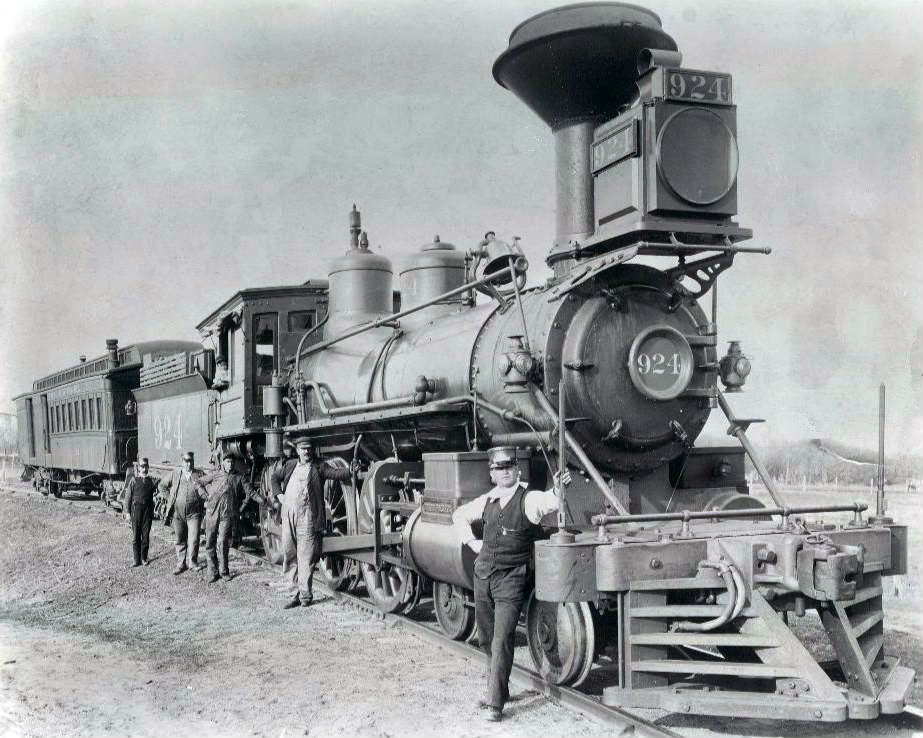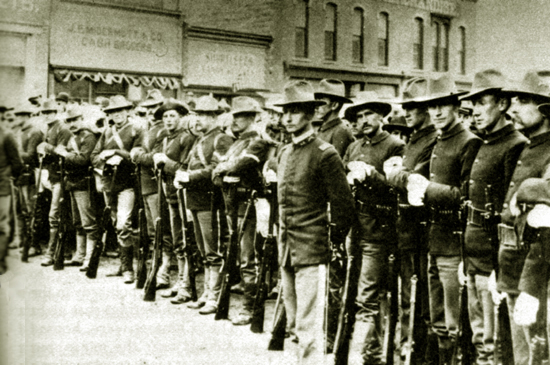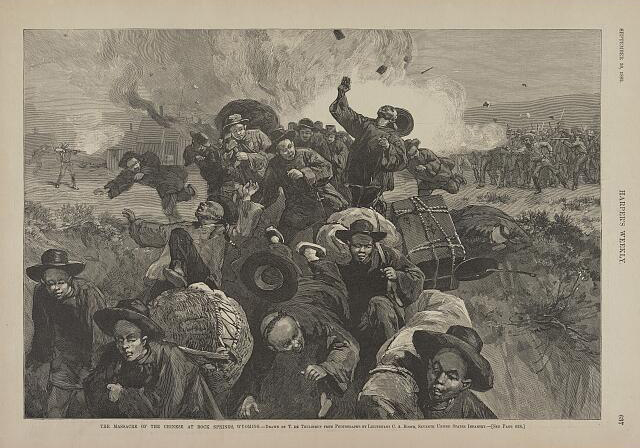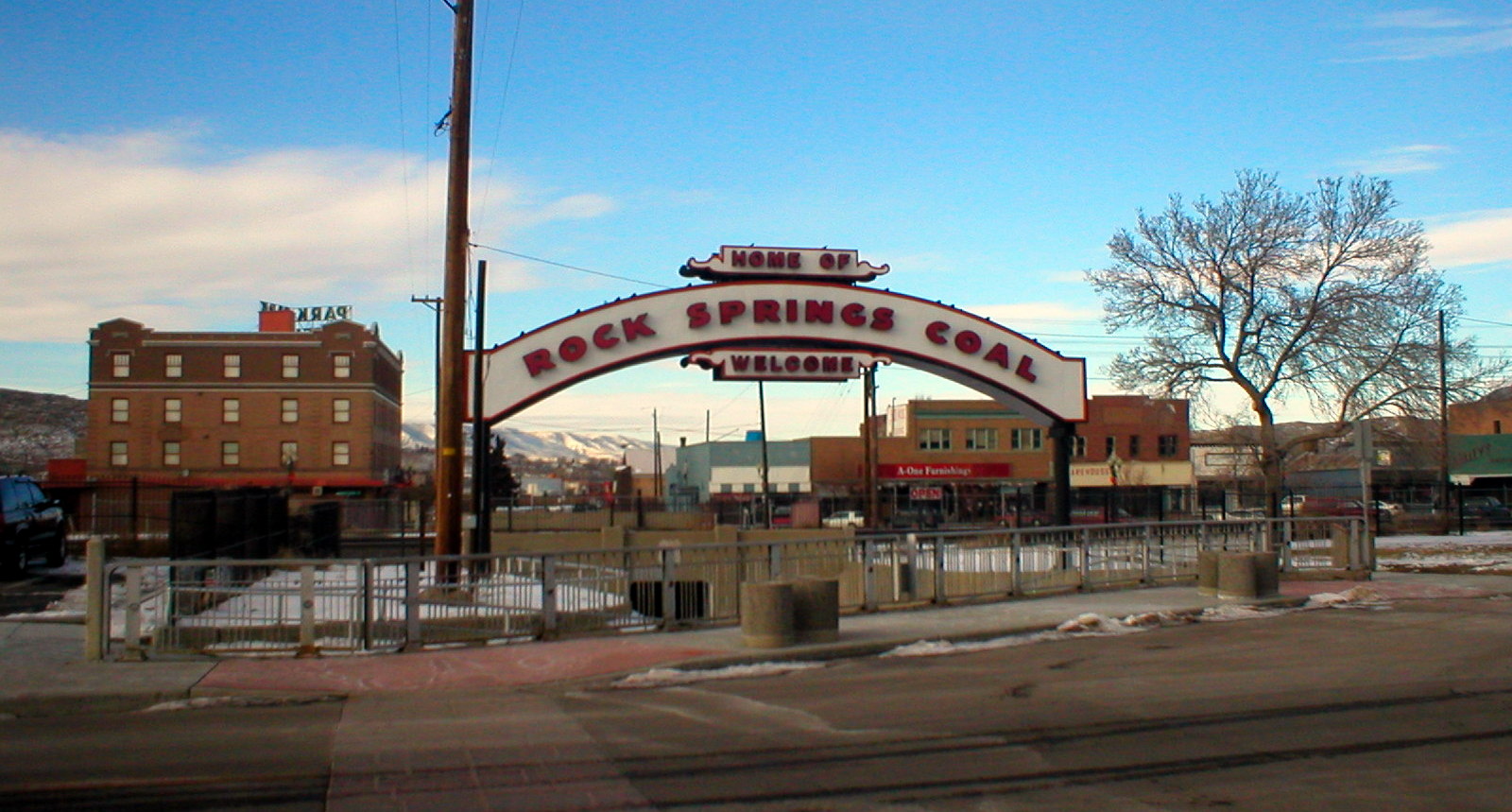“The massacre of the Chinese at Rock Springs, Wyoming / drawn by T. de Thulstrup from photographs by Lieutenant C.A. Booth, Seventh United States Infantry.” This print shows Chinese immigrant miners who worked for the Union Pacific Coal Company fleeing from armed White miners.
Credit: Library of Congress (No known restrictions on publication.)
Grade: 7-10Subject:
U.S. History, Social Studies, English Language Arts
Number of Activities: 5
On September 2, 1885, White coal miners in the Rock Springs, Wyoming territory led a riot with the goal of expelling Chinese laborers from town. That evening, twenty-eight Chinese miners were killed and fifteen injured, and all the houses in Chinatown destroyed. In this lesson, students will learn about the factors that led to the Rock Springs Massacre as well as the outcomes and effects of the event.
Students will:
- Describe the events and factors that led to the Rock Springs Massacre.
- Analyze connections among the events related to the Rock Springs Massacre.
- Analyze primary source accounts of the Rock Springs Massacre.
Rock Springs Massacre Essay:
The California gold rush (1848-1855) drew large numbers of Chinese immigrants to the United States seeking financial opportunities. Many of these laborers went on to build the
Transcontinental Railroad, while others found work such as opening laundries and restaurants. With the completion of the railroad in 1869, many workers began looking for new work.
In 1870, many Chinese laborers began moving to the Rock Springs, Wyoming
territory. (Wyoming became a state in 1890.) The Union Pacific Railroad, one of the two companies that built the Transcontinental Railroad, hired Chinese workers to work in the coal mines in Rock Springs. These coal mines powered the trains. By 1885, there were about 600 Chinese and 300 White miners working in the Rock Springs mines. White miners typically lived in downtown Rock Springs, while Chinese miners lived in the northeast of town in the area that became known as “Chinatown.”
Chinese laborers were willing to accept low wages. This meant that the Union Pacific Railroad kept wages low for everyone. White miners formed a
union called the Knights of Labor. Their goal was to improve working conditions and increase wages by organizing
strikes. The Knights of Labor blamed the Chinese workers for the low wages. They organized a strike in 1884. As a result of the strike, the Union Pacific Railroad planned to only hire Chinese workers. This increased the White miners’ resentment. Tensions between White and Chinese workers escalated. White workers began planning an
expulsion of Chinese workers from the Wyoming territory.
On the morning of September 2, 1885, White miners and Chinese miners got into a fight in the No. 6 mine in Rock Springs. The White miners killed one Chinese miner and badly injured another. A
foreman arrived and broke up the fight. However, tensions remained high. Instead of continuing to work, White workers went home to retrieve weapons.
By the afternoon, a mob of between 100-150 armed White men gathered and then split up to surround Chinatown. Women and children joined them as well. They began attacking Chinese people in their homes and on the streets, and set houses on fire. By the evening, twenty-eight Chinese miners were killed and fifteen injured. All of the houses in Chinatown were destroyed.
Following the massacre, the surviving 500 Chinese workers fled to nearby Evanston. It was a railroad town about 100 miles from Rock Springs that serviced locomotives. Many coal miners, including Chinese miners, lived in Evanston. The Chinese workers were eager to leave Wyoming. They asked their employer, the Union Pacific Railroad, for tickets and
back pay owed to them. The company refused both requests. On September 9, 1885, federal troops took the Chinese workers to a train depot in Evanston and told them they were headed to San Francisco for safety. However, they were actually tricked into returning to Rock Springs and were returned there that evening. The Union Pacific Railroad demanded the Chinese workers get back to work. Many of them initially refused, but seeing no other option, they ultimately returned to work.
Years later, under pressure from President Grover Cleveland (1837-1908), Congress allotted $150,000 in
reparations for their property losses. Sixteen White miners were arrested, but none were charged with a crime. Out of fear, no one was willing to
testify against them. Federal troops stayed in Rock Springs for thirteen years after the massacre to maintain order and prevent future violence.
The Rock Springs Massacre was not an isolated event. White workers in the region were emboldened after the massacre. Just a few months later, the Tacoma Riot broke out on November 3, 1885. A mob of around 500 people drove the Chinese community out of Tacoma, Washington and burned the city's two Chinatowns. In February 1886, a mob forced Seattle’s Chinese population out of town.
Sadly, violence against Chinese Americans and other Asian Americans are a part of U.S. history. These communities have continued to seek safety in order to survive and thrive.
Bibliography:
Lee, Erika. (2015). The Making of Asian America: A History. New York: Simon & Schuster.
- Back pay: money that is owed to a worker from an earlier time
- Expulsion: the act of expelling, or forcing out
- Foreman: a person in charge of a group of workers
- Reparations: the act of making amends for a wrong or injury; the payment of damages to make amends
- Strike: to stop work in order to force an employer to comply with demands
- Territory: a part of the U.S. not included within any state but organized with a separate legislature
- Testify: to make a solemn declaration under oath for the purpose of establishing a fact (as in a court)
- Transcontinental Railroad: railroad line built between 1863-1869 that connected the eastern U.S. rail network at Council Bluffs, Iowa with the Pacific coast in the San Francisco Bay
- Union: an organization of workers formed for the purpose of advancing its members' interests in respect to wages, benefits, and working conditions
- Why did Chinese laborers move to Rock Springs, Wyoming?
- How was the Union Pacific Railroad able to pay their workers low wages?
- Who were the Knights of Labor? What were their goals?
- What happened during the Rock Springs Massacre?
- Why did the Union Pacific Railroad refuse to help the Chinese workers who fled to Evanston?
- How were Chinese laborers tricked into returning to Rock Springs?
- Why were White miners not charged with a crime following the Rock Springs Massacre?
- How did the Rock Springs Massacre lead to other acts of violence against the Chinese?
Modern day photo of Rock Springs, Wyoming. In the late 1800s, Rock Springs, Wyoming territory was a coal mining town. By 1885, there were about 600 Chinese and 300 White miners working in the Rock Springs mines.
Credit: Milonica at en.wikipedia,
CC BY-SA 3.0, via Wikimedia Commons
Activity 1: Contextualizing Anti-Chinese Sentiment
- Have students watch the video entitled, “Chinese Exclusion Act and the Exclusion of Asians, Pacific Islanders & Chinese Women.”
- Facilitate a discussion by asking the following questions:
- How is the influx of Chinese immigration connected to the abolition of slavery in the United States?
- How did the idea that the Chinese were a threat to American laborers emerge?
- How would you describe public sentiments toward Chinese people at this time?
- Tell students the following: “After the abolition of slavery, immigrant labor addressed the need for cheap labor. Chinese immigrants were often recruited as a source for cheap labor. As a result, many White laborers saw Chinese laborers as a threat. This led to racism and violence against the Chinese.”
- Have students write a Quickwrite given this prompt: “Describe a time when you felt threatened. What happened? What did you do?”
- Facilitate a discussion by asking the following questions:
- What does it mean to feel threatened?
- What are some reasons why people might feel threatened?
- What are some possible reactions to feeling threatened?
- What are more appropriate ways to handle feeling threatened?

A Union Pacific steam locomotive built in 1868. Union Pacific Railroad, one of the two companies that built the Transcontinental Railroad, hired Chinese workers to work in the coal mines in Rock Springs.
Credit: Union Pacific Railroad, Public domain, via Wikimedia Commons
Activity 2: Learning about the Rock Springs Massacre
- Have students read the essay. Consider the following options:
- OPTION 1: Have students read the essay independently either for homework or during class time.
- OPTION 2: Read aloud the essay and model annotating.
- OPTION 3: Have students read aloud in pairs or small groups.
- Facilitate a class discussion by asking students the Discussion Questions.
- Create and display the following chart for all to see:
|
|
Goals
|
Strategies
|
|
Chinese workers
|
|
|
|
White workers
|
|
|
|
Union Pacific Railroad
|
|
|
- Have students use information from the essay to complete the chart:
- Have students identify the goals of each group (i.e., Chinese workers, White workers, and Union Pacific Railroad) in the middle column.
- Have students identify strategies each group used to accomplish their goals in the right column.
- Facilitate a discussion using the following questions:
- What similarities were there among the goals and strategies of the three groups? What accounts for these similarities?
- What differences were there among the goals and strategies of the three groups? What accounts for these differences?
- How did the Union Pacific Railroad pit White and Chinese workers against each other to meet their goals?
Activity 3: Researching Events Related to the Rock Springs Massacre
- Have students work in small groups. Assign each group to study one of the following events:
- Group 1: California Gold Rush
- Group 2: Building of the Transcontinental Railroad
- Group 3: Chinese Massacre of 1871
- Group 4: Knights of Labor in Wyoming
- Group 5: Tacoma Riot of 1885
- Group 6: Seattle Riot of 1886
- Group 7: Massacre at Hells Canyon (1887)
- Have students research and then write a brief summary (5-10 sentences) of their assigned event by referring to the essay and/or additional internet research. Have students create a poster featuring their summary, a visual, and a caption.
- Have each group present their poster to the entire class, in chronological order.
- Facilitate a discussion by asking the following questions:
- How are these events connected?
- Which events led to the Rock Springs Massacre? What caused the Rock Springs Massacre? Which causes do you think were most significant and why?
- Which events were effects of the Rock Springs Massacre?
- How did the Rock Springs Massacre lead to more anti-Chinese and anti-Asian violence?
- Why is it important to understand what happened before, during, and after the Rock Springs Massacre?

Federal Troops on South Front Street in Rock Springs, 1885. Federal troops stayed in Rock Springs for thirteen years after the massacre to maintain order and prevent future violence.
Credit: Wyoming Tales and Trails, via Wikimedia Commons. (Public Domain)
Activity 4: Analyzing Primary Source Accounts of Rock Springs Massacre
- Distribute the worksheet entitled, “Primary Source Analysis.” (Tell students the following: “A primary source is a firsthand account of an event or topic. Primary sources are created by people who witnessed or participated in the event or topic.”)
- Have students read the primary source entitled, “‘To This We Dissented’: The Rock Springs Riot."
- Have students work in small groups to complete the Primary Source Analysis.
- Have students write information related to sourcing in the “Sourcing” section to include:
- Type of document
- Title of document
- Author
- Date
- Intended audience
- Have students respond to the following questions in the “Contextualizing” section:
- What was happening at the time this was written? Explain the historical context.
- How does this document fit into and explain that historical context?
- Have students respond to the following questions in the “Analyzing” section:
- What claims does the author make?
- What evidence does the author make to support their claims?
- What language (word choice, phrases, etc.) does the author use to support their claims?
- Facilitate a discussion using the following questions:
- How does this firsthand account by the Chinese workers corroborate what you have already learned?
- How does this account add additional dimension to your understanding of the Rock Springs Massacre?
- Is this source helpful in understanding the Rock Springs Massacre? Why or why not?
- Distribute a second copy of the worksheet entitled, “Primary Source Analysis.”
- Have students read the primary source entitled, “‘Rock Springs is Killed’: White Reaction to the Rock Springs Riot.” Have students complete the Primary Source Analysis worksheet for this source.
- Facilitate a discussion using the following questions:
- How does this editorial corroborate what you have already learned?
- How does this account add additional dimension to your understanding of the Rock Springs Massacre?
- Is this source helpful in understanding the Rock Springs Massacre? Why or why not?
- Why is it important to read accounts from multiple perspectives in seeking to understand history?
Activity 5: Summarizing Causes and Effects of the Rock Springs Massacree
- Have students write an essay summarizing the causes and effects of the Rock Springs Massacre. Have students use their research from Activity 3 and their primary source analyses from Activity 4 as evidence. Have students choose at least two causes and two effects to include.
- Have students read this webpage entitled, “Help Support the Requiem Sculpture.” Have students write a proposal for other ways to memorialize the victims of the Rock Spring Massacre. Have students address how their proposal addresses both understanding and healing and how it accounts for the causes and effects of the Rock Springs Massacre (that they wrote about in the previous activity).
- Have students complete the worksheet entitled, “Chinese Massacre of 1871 - Comparison Research Organizer” by comparing and contrasting the Rock Springs Massacre with other massacres in U.S. history. Examples include: Chinese Massacre of 1871, Bellingham Riot in 1906, Hanapepe Massacre of 1924.
-
Have students research and learn more about the Knights of Labor. Tell students the following: “The Knights of Labor was progressive in many ways; for example, it was a pro-worker union and is believed to be the first multi-racial labor union in the country. However, it was also anti-Chinese and advocated for legislation like the Chinese Exclusion Act of 1882.” Have students generate questions about the Knights of Labor and conduct research to find answers.
D2.His.1.6-8.
Analyze connections among events and developments in broader historical contexts.
D2.His.14.6-8.
Explain multiple causes and effects of events and developments in the past.
D2.His.15.6-8.
Evaluate the relative influence of various causes of events and developments in the past.
D2.His.16.6-8.
Organize applicable evidence into a coherent argument about the past.
D2.His.13.6-8.
Evaluate the relevancy and utility of a historical source based on information such as maker, date, place of origin, intended audience, and purpose.
CCSS.ELA-Literacy.RH.6-8.1
Cite specific textual evidence to support analysis of primary and secondary sources.
CCSS.ELA-Literacy.RH.6-8.2
Determine the central ideas or information of a primary or secondary source; provide an accurate summary of the source distinct from prior knowledge or opinions.
CCSS.ELA-Literacy.RH.6-8.6
Identify aspects of a text that reveal an author's point of view or purpose (e.g., loaded language, inclusion or avoidance of particular facts).





